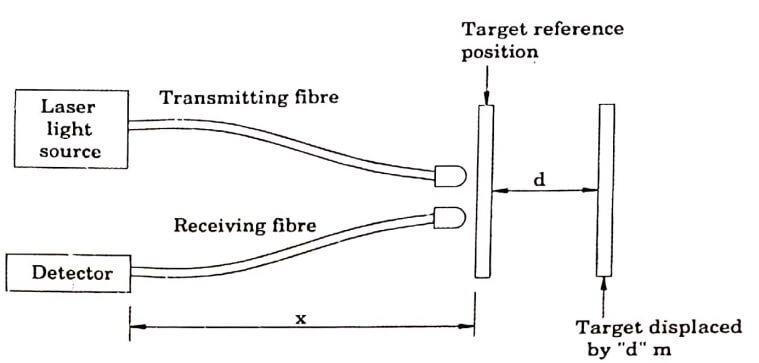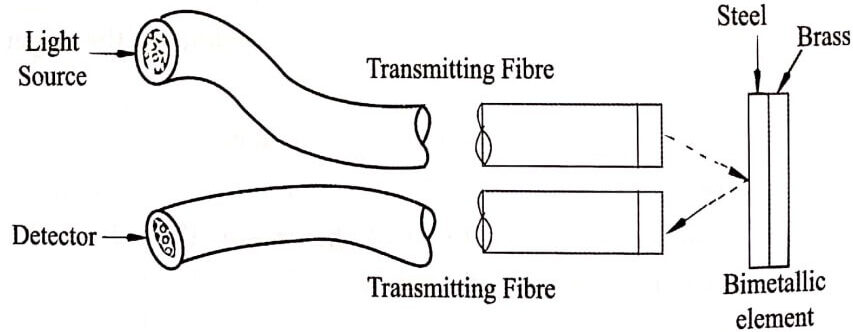Fibre optic sensor is a transducer which can converts various input variables (physical quantity) into an electrical signal in a measurable form. The fibre optic sensors are used for measuring and sensing various parameters like temperature, electric field, magnetic field, current, humidity, acoustic vibrations and so on.
Principle: Light energy is fed to one end of the optical fibre and detected by a detector at the other end. By comparing the changes in intensity or phase of light, the physical quantity can be measured.
Types of sensors
(ii). Extrinsic sensors (or) Passive sensors.
(i) Intrinsic sensors
In intrinsic sensors, the measured quantity acts directly on the fibre itself and produces a change in the transmission characteristics.
Example : Temperature sensor, pressure sensor
(ii) Extrinsic sensors
In extrinsic sensors, the measured quantity is applied on the fibre, in addition to the sensor fibre, another external fibre with the same material is also used.
Example : Displacement sensor, velocity meter sensor
The major advantages of using optical fibres in sensing applications are,
-
They are light in weight and are small in size.
-
They have good geometrical flexibility.
-
Fibre optic sensors are free from the risk of sparks since, they are made of silica.
-
They are electrically passive (i.e.) they are immune to electromagnetic interference and also do not distort due to the surrounding electrical and magnetic fields.
-
These sensors have large bandwidth and are highly sensitive.
Displacement sensor
Principle
The intensity modulation of the transmitted light beam is used to make a measurement of the displacement of the moving object.
Construction
The (Fig. 1.1) shows the arrangement of displacement sensor. In this type of sensor, one end of the transmitting fibre is coupled to a laser source and the other free end is made to a face a target at a distance x metre.
Similarly, one end of the receiving fibre is connected to a detector and its free end is made to face the same target.

Fig 1.1 Displacement sensor
Working
- A beam of light is made to fall over the target at a distance x metre from the transmitting end of the fibre.
- The light after getting reflected from the target is collected by the detecting fibre and is detected by the detector.
- Hence, the displacement of an object is related to the intensity of the light arriving at the detector.
- Thus, there will be either an increase in intensity or decrease in intensity depending on whether the distance of the target decreases or increases.
- Hence, the position of the target can be measured using the optical detector.
- To increase the sensitivity of the sensor, the axis of the transmitting fibre and the receiving fibre must be in a specific angle with respect to one another and also to the target.
Temperature sensor
Principle
The temperature is measured by the intensity modulation of the reflected light from the target (bimetallic strip). Depending on the curvature of the bimetallic strip due to change in temperature the amount of reflected light also varies in a linear manner. The change in intensity of the reflected light is directly proportional to the change in temperature.
Construction
It consists of steel and brass which are welded together to form a strip. Here, the bimetallic strip acts as the sensing element. The linear expansivity will be on the outside of the arc when the strip is heated. The strip is attached to a bifurcated reflective fibre optic probe. The strip is designed to move continuously and its movement is directly proportional to temperature.

Fig 1.2 Intensity modulated temperature sensor
Working
- The light from the light source is transmitted through the multimode fibre bundle and is made to incident on the bimetallic strip.
- Its shape is now changed due to increase of temperature. The reflected light is collected by another multimode fibre bundle and given to the photo detector.
- The amount of the reflected light is converted into voltage by the photo diode or photovoltaic cell detector. (Fig.1.2) shows the linear response of this temperature sensor.
- The amount of light reflected decreases with the increase of temperature. So that the output of the photo diode decreases with the increase of temperature.
- The output of the photo diode is calibrated in terms of temperature.
| Read More Topics |
| Fibre optical communication system |
| Losses in optical fibre |
| Industrial applications laser welding |





